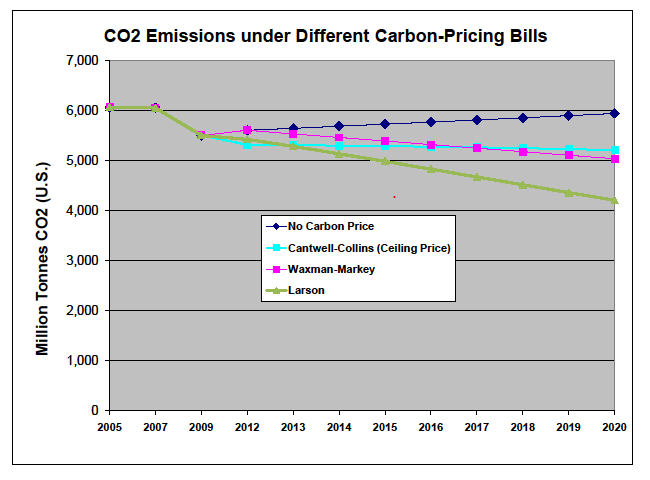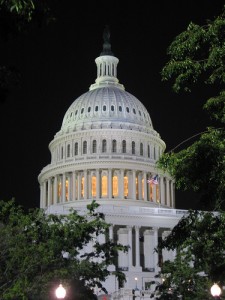New York City Mayor Michael Bloomberg’s endorsement yesterday of President Obama’s re-election may have caught the political class by surprise, but not the Carbon Tax Center.
It was five years ago today, in Seattle, at a climate summit organized by the U.S. Conference of Mayors, that Bloomberg made a full-throated appeal to Congress to enact a carbon tax. His speech then, on Nov. 2, 2007, remains the most passionate and compelling call for truly effective climate action by any major American political figure.
The Carbon Tax Center’s New York headquarters are currently off the grid, due to Superstorm Sandy. We hope to be back around Election Day with fresh commentary, including discussion of whether the President’s first-term climate program and second-term outlook merited Bloomberg’s endorsement. For now, to show what real climate leadership looks like, please feast on the full text of Mayor Bloomberg’s 2007 speech, included here, courtesy of The New York Times. (The mayor’s extensive discussion of carbon taxing comes toward the end.)
— Charles Komanoff
Remarks by New York City Mayor Michael R. Bloomberg, in Seattle, Washington, Nov. 2, 2007, before the U.S. Conference of Mayors’ “Climate Protection Summit”
I’ve had the pleasure of working with Mayor Palmer, Mayor Nickels, Mayor Diaz — and many others in this room — through our coalition of Mayors Against Illegal Guns, which now includes more than 240 mayors from all around the country — Republicans, Democrats, and independents. If you haven’t joined yet, we’d love to have you — and I think illegal guns and climate change are two of the best examples of cities leading where Washington has not. On both issues, those in Washington prefer talk to action. On illegal guns, they extol the virtues of the Second Amendment, which is all well and good, but let’s get serious: protecting the Second Amendment does not stop you from keeping illegal guns out of the hands of criminals. It’s just a political duck-and-cover that allows legislators to escape responsibility for fixing a serious problem. And innocent people — and police officers — are dying as a result.
On climate change, the duck-and-cover usually involves pointing the finger at others. It’s China-this and India-that. But wait a second. This is the United States of America! When there’s a major challenge, we don’t wait for others to act. We lead! And we lead by example. That’s what all of us here are doing.
This conference has highlighted just how much local leadership there is on the issue of climate change and how many innovative new projects are going on in cities around the country: Seattle’s incentives for greening existing buildings, Los Angeles’s million tree initiative, Miami’s bus rapid transit program — and the list goes on. When we developed our long-term sustainability plan in New York, which we call PlaNYC, we made no apologies for stealing the very best ideas — and we came up with some of our own, including converting our 13,000 taxis to hybrids or high-efficiency vehicles. This will not only help clean our air and reduce greenhouse-gas emissions, it will save each driver about $4,500 a year in gas costs.
Cities and states are both taking action, but the fact is, no matter how far we push the boundaries of the possible, there will be no substitute for federal leadership. Leadership is not waiting for others to act, or bowing to special interests, or making policy by polling or political calculus. And it’s not hoping that technology will rescue us down the road or forcing our children to foot the bill. Leadership is about facing facts, making hard decisions and having the independence and courage to do the right thing, even when it’s not easy or popular. We’ve all heard people say, “It’s a great idea, but for the politics.” And let me give you just one example from New York.
Last spring, as part of our PlaNYC initiative, we proposed a system of congestion pricing based on successful programs in London, Stockholm and Singapore. The plan would charge drivers $8 to enter Manhattan on weekdays from 6 a.m. to 6 p.m., which would help us reduce the congestion that is choking our economy, the pollution that has helped produce asthma rates that are twice the national average, and the carbon dioxide that is fueling global warming.
Now, the question is not whether we want to pay, but how do we want to pay. With an increased asthma rate? With more greenhouse gases? Wasted time? Lost business? Higher prices? Or do we charge a modest fee to encourage more people to take mass transit and use that money to expand mass transit service? When you look at it that way, the idea makes a lot of sense, but for the politics, because no one likes the idea of paying more. But being up front and honest about the costs and benefits, we’ve been able to build a coalition of supporters that includes conservatives and liberals, labor unions and businesses, and community leaders throughout the city.
There is no problem that can’t be solved if we have the courage to confront it head-on — and put progress above politics. Mayors around the country are doing it — and those in Washington can, too. I believe it’s time for both ends of Pennsylvania Avenue to come together around a national strategy on climate change and to lead the way on an international strategy. And I believe that until they do, it’s our job as mayors to point the way forward. That’s why right after this conference, several of us will be testifying before a House committee that is holding a hearing on climate change here in Seattle. It’s why I’m pleased to announce that New York City has recently joined a new campaign being launched by The Climate Group called “Together.” It will unite businesses, think tanks, advocacy groups, faith-based organizations, and cities — and I urge all of the cities in this room to join, and to invite your neighbors. It will be a national effort to help all Americans make a difference in the fight against climate change. And it’s why next month, I will go to the U.N. climate change summit in Bali, in the South Pacific, as a guest participant, and to support our delegation.
It’s time for America to re-establish its leadership on all issues of international importance, including climate change. Because if we are going to remain the world’s moral compass — a role that we played throughout the 20th century, not always perfectly, but pretty darn well — we need to regain our footing on the world stage. That means ending the “go-it-alone” approach to foreign affairs that has never served America well. It didn’t work in the 1920s, when we tried to isolate ourself from the world, and it hasn’t work in recent years, when we’ve tried to stand above it, pretending that vital international treaties can simply be ignored. The fight against global warming is a test of America’s leadership — and not just on the environment.
Climate change presents a national security imperative for us, because our dependence on foreign oil has entangled our interests with tyrants and increased our exposure to terrorism. It’s also an economic imperative, because clean energy is going to fuel the future. Jobs are on the line here — good jobs of every kind: Farm jobs. Factory jobs. Engineering jobs. Sales jobs. Management jobs. If we don’t capture these jobs, they’ll just move overseas. Green energy is going to be the oil gusher of the 21st century, and if we’re going to remain the world’s economic superpower, we’ve got to be the pioneers — just as America always has been.
How do we do it? I think we need a strategy that embraces four basic principles, and I’d like to briefly outline them today. First, we need to increase investment in energy R & D. Right now, we’re spending just one-third of what we were in the 1970s. If we really want to be able to manufacture competitively priced biofuel and solar power, if we really want to sequester the carbon dioxide released from coal, we have to be willing to make the commitments that will drive private capital to these projects — and right now, we’re just not doing that.
Second, we have to stop setting tariffs and subsidies based on pork barrel politics. For instance, Congress is currently subsidizing corn-based ethanol at 50 cents a gallon — and you can argue that’s good agricultural policy, but you can’t argue that it’s good for consumers or the environment. Because it isn’t. Consumers pay more for food, and producing corn-based ethanol results in much more carbon dioxide than producing sugar-based ethanol. But are we subsidizing sugar-based ethanol? No! We’re putting a 50-cent tariff on it. Ending that tariff makes all the sense in the world, but for the politics. Everyone knows that politically driven policies are costing taxpayers billions while providing only marginal carbon reductions — but we need leaders who will do something about it!
Third, we have to get serious about energy efficiency — and the best place to start is with our cars and trucks. In 1975, Congress passed a law requiring fuel efficiency standards to double over 10 years, from 12 miles a gallon to 24, with incremental targets that auto manufacturers were required to meet. But since 1985, Washington has been paralyzed by special interests. If the same incremental gains had been adopted for the last two decades, think of where we would be now! We’d all be saving money at the pump, we’d be producing less air pollution and greenhouse gas, Detroit would be in a stronger competitive position and the “Big Three” may not have lost so many more jobs. (Just yesterday, Chrysler announced another 12,000 job cuts.)
Those job losses hurt hard-working Americans, and we have to ask ourselves: Do we want even more middle-class factory workers to be handed pink slips and left to look for service jobs at half the wages? Because that’s the direction we’re heading in if we continue to fall further and further behind other countries in producing fuel-efficient vehicles. The current Senate energy bill would raise Corporate Average Fuel Economy (CAFE) standards from 27.5 to 35 miles per hour by 2020. That’s nowhere near the leap we made from 1975 to 1985, and many foreign cars are already getting 35 miles to the gallon. Even so, U.S. automakers are trying to water down the Senate bill — and if Congress caves, you can bet the loudest cheers will be heard in Japan. Raising fuel efficiency standards is the best thing we could do for U.S. automakers — and it would’ve been done years ago, but for the politics.
Fourth and finally, we have to stop ignoring the laws of economics. As long as greenhouse gas pollution is free, it will be abundant. If we want to reduce it, there has to be a cost for producing it. The voluntary targets suggested by President Bush would be like voluntary speed limits — doomed to fail. If we’re serious about putting the brakes on global warming, the question is not whether we should put a value on greenhouse gas pollution, but how we should do it. This is where the debate is moving, and I’d like to briefly touch on the pros and cons of the two approaches that are most often discussed: creating a cap-and-trade system, and a putting a price on carbon.
Both of these ideas share the same goal: raising the cost of producing greenhouse gas pollution. If you want less of something, every economist will tell you to do the same thing: make it more expensive. Of course, none of us wants to pay more for electricity or gas or anything else. Rising energy costs, rising health costs, rising college tuition — the middle class is getting squeezed left and right. But raising the cost of pollution can actually save taxpayers money in the long run — and I’ll explain how in a minute. But first, you might be thinking: “Wait a second. Five years ago, oil was selling at $30 a gallon. Now it’s selling at more than $90, and we’re not buying any less of it. So why would raising the cost of carbon make any difference?” The answer is: It would and it wouldn’t. People are going to keep buying gas whether it costs $1 a gallon or $2.75 a gallon — or even more — because the demand for gas is inelastic. But the demand for coal is far more elastic than oil, and so if its price goes up, many power plants would likely switch to natural gas, which is much cleaner, and the 100 coal plants that are now on the drawing boards would likely convert to natural gas as well. Raising the cost of carbon would also make alternative energy sources more cost-competitive, which would lead more consumers and property owners to make the switch.
To raise the cost of carbon, we can take either an indirect approach — creating a cap-and-trade system of pollution credits — or a direct approach: charging a fee for greenhouse gas pollutants. The question is: Which approach would be more effective? I’ve talked to a number of economists on this issue, people like Gilbert Metcalf at the National Bureau of Economic Research, and every one of them says the same thing: A direct fee is the better approach — but for the politics. There’s that phrase again: “But for the politics!”
Cap-and-trade is an easier political sell because the costs are hidden — but they’re still there. And the payoff is more uncertain. Because even though cap-and-trade is intended to incentivize investments that reduce pollution, the price volatility for carbon credits can discourage investment, since an investment that might make sense if carbon credits are trading at $50 a ton may not make sense at $30 a ton. This price volatility can also lead to real economic pain. For instance, if 100 companies release higher emissions than they had planned for, they all have to buy more credits, which can create a very expensive bidding war. That’s exactly what’s happening in parts of Europe right now, and it’s going to cost companies there billions of dollars.
There are also logistical issues with cap-and-trade. The market for trading carbon credits will be much more complex and difficult to police than the market for the sulfur dioxide credits that eliminated acid rain. And there are political issues — because the system is subject to manipulation by elected officials who want to hand out exemptions to special interests. A cap-and-trade system will only work if all the credits are distributed from the start — and all industries are covered. But this begs the question: If all industries are going to be affected, and the worst polluters are going to pay more, why not simplify matters for companies by charging a direct pollution fee? It’s like making one right turn instead of three left turns. You end up going in the same direction, but without going around in a circle first.
A direct charge would eliminate the uncertainty that companies would face in a cap-and-trade system. It would be easier to implement and enforce, it would prevent special interests from opening up loopholes and it would create an opportunity to cut taxes.
I was in England a month ago talking to the Conservative Party, which has proposed a series of revenue-neutral “green taxes” that would be offset by reductions in other taxes. I believe that approach merits consideration — and the most promising idea I’ve heard is to use the revenue from pollution pricing to cut the payroll tax. After all: Employment is good, pollution is bad. Why shouldn’t we lower the cost of the good and raise the cost of the bad? Studies show that a pollution fee of $15 for every ton of greenhouse gas would allow us to return about $500 a year to the average taxpayer. And a charge on pollution would be less regressive than the payroll tax, because the more energy you consume, the more you would pay. That would give us all of us an incentive to reduce our energy use — whether that’s buying a more fuel efficient appliance, or making the switch to compact fluorescent light bulbs, as we’ve done in New York’s City Hall – and as I’ve done in my own home. Under this approach, even though energy costs would rise, the savings from tax cuts and energy efficiencies could, over the long run, leave consumers with more money in their pockets.
Creating a direct charge for greenhouse gas pollution would also incentivize the kinds of innovation that a cap-and-trade system is designed to encourage — without creating market uncertainty. To do this, a portion of the revenue from the pollution charge would be used to create an innovation fund, which would finance tax credits for companies that reduce their greenhouse gas pollution. As a result, companies would have two big incentives to reduce their pollution: minimizing the charges they would have to pay and maximizing their tax savings. And unlike a cap-and-trade system, the certainty of tax credits would be more likely to lead companies to make the long-term investments in clean technology that will allow us to substantially reduce greenhouse gas pollution.
Both cap-and-trade and pollution pricing present their own challenges — but there is an important difference between the two. The primary flaw of cap-and-trade is economic — price uncertainty. While the primary flaw of a pollution fee is political, the difficulty of getting it through Congress. But I’ve never been one to let short-term politics get in the way of long-term success. The job of an elected official is to lead – not to stick a finger in the wind. It’s to stand up and say what we believe — no matter what the polls say is popular or what the pundits say is political suicide.
From where I sit, having spent 15 years on Wall Street and 20 years running my own company, the certainty of a pollution fee — coupled with a tax cut for all Americans — is a much better deal. It would be better for the economy, better for taxpayers and — given the experiences so far in Europe — it would be better for the environment. I think it’s time we stopped listening to the skeptics who say, “But for the politics” and start being honest about costs and benefits. Politicians tend to prefer cap-and-trade because it obscures the costs. Some even pretend that it will lower costs in the short run. That’s nonsense. The costs will be the same under either plan — and if anything, they will be higher under cap-and-trade, because middlemen will be making money off the trades. (I happen to love middlemen. They use Bloomberg terminals and support my daughters. But what’s right is right!)
For the money, a direct fee will generate more long-term savings for consumers, and greater carbon reductions for the environment. And I don’t know about you, but when the economists say one thing and the politicians say another, I’ll go with the economists.
Of course, I also understand that you can’t let the perfect be the enemy of the good. Whether it’s a direct fee or cap-and-trade, we can’t be afraid to try something — to do something — to act. As mayors, we’re all familiar with those who respond to every problem by saying, “Do another study,” or by scaring voters with doom-and-gloom predictions. That approach is why we have health care costs that have spiraled out of control, it’s why we have public school systems that were allowed to collapse, and it’s why we’re still fighting poverty with the same old programs that haven’t worked.
But remember, this is America! We can’t be afraid to lead, to innovate, to experiment. Cities aren’t afraid. We’re showing that we can do better, we can make progress, and we can do it in a way that is good for the environment and the economy. It’s time for Washington to do the same and to show the world that America is ready to be a leader. When our representatives run for re-election or higher office, they talk about “a chicken in every pot.” But why not tell us who’s going to pay, how it’s going to work, when it’s going to be implemented, and if it doesn’t work, what’s Plan B? We need our leaders to have the courage to talk about and implement real climate change solutions, not just because it’s good for the world, but because it’s good for America, our environment, our national security and our economy. Make no mistake: Real jobs are on the line here — because cleaner energy sources are going to be a cornerstone of the 21st-century economy.
If we’re going to remain the world’s economic superpower, we have to create predictable incentives that will drive technological innovations and allow us to lead the world in developing clean, reliable and affordable energy. We can do it! If we stop saying: But for the politics!
In the weeks and months ahead, our job is not just to continue innovating — but to demand that those in Washington join us. Tell them that it’s O.K. to stand up and be honest about the costs and benefits of real solutions. We’ve done it — and we’ve not only lived to tell the tale, we’ve won support and respect from our constituents. They can, too. And we’ve got to hold them accountable for doing it. So let’s get to work.












 The House
The House